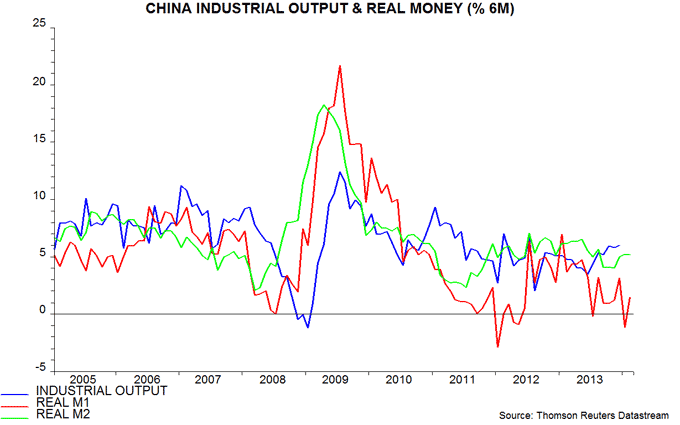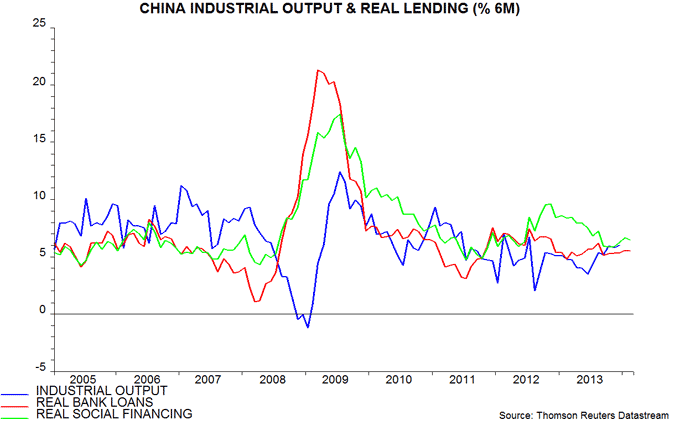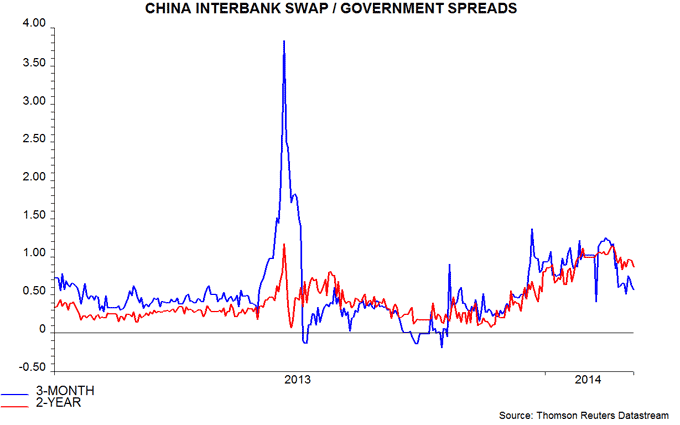Entries from March 9, 2014 - March 15, 2014
Japan's QE blitz yields disappointing results
QE enthusiasts expected the bond-buying blitz launched by incoming Bank of Japan Governor Kuroda in April 2013 to boost the broad money supply substantially – one commentator suggested a 10% increase over a year. The view here was sceptical, on the grounds that higher BoJ purchases would be largely offset by stepped-up selling by banks, whose demand for liquid securities would fall as QE expanded their reserves – see previous post.
This view, so far at least, has proved correct. Banks reduced their investment account holdings of Japanese government bonds by a further ¥5.8 trillion in January (the latest available month), neutralising two-thirds of the impact of BoJ buying of ¥8.4 trillion. Annual growth of the broad M3 money supply measure slipped back to 3.2% in February – little changed from 2.5% in March 2013.
The QE lift to nominal money supply growth has been more than offset by higher inflation due mainly to the weaker yen. Real money expansion is lower now than in early 2013, helping to explain recent disappointing economic performance – see chart.
What happens next? Inflation will be boosted mechanically by next month’s sales tax hike but the yen effect is now fading and wage rises remain muted. If nominal money growth is stable, real trends may improve later in 2014 as price rises moderate, promising better economic conditions in 2015.
The risk is that the BoJ will raise the QE stakes, leading to further yen weakness that keeps inflation elevated and real money growth depressed – assuming, reasonably, that QE pass-through to nominal money trends remains minimal.
The BoJ, in other words, may sacrifice economic growth on the altar of its obsession to achieve 2% inflation.
Global leading indicators softening but monetary trends reassuring
Global short and longer-term leading indicators followed here suggest that recent slower economic growth will persist through late spring. As expected, the short indicator (average 2-3 month lead at turning points) fell further in January, while the longer measure (4-5 months) stabilised – see first chart. Six-month global industrial output growth appears to have peaked at end-2013 and, based on these readings, may decline into April / May.
The stabilisation in the longer-term leading indicator is tentative, subject to revision and should not be overemphasised. It is, however, consistent with a revival in global real narrow money expansion that started in December and continued in February, judging from early data – second chart*. Allowing for an average 6-7 month lead, this suggests a recovery in global economic momentum in mid-2014. The further rise in real money growth in February was driven by US strength and a reversal of weakness in China – see Monday’s post.
The investment implications of these divergent trends are open to debate. A possible scenario is that elevated equity markets will correct as near-term economic data softens before rebounding in anticipation of the stronger second half implied by monetary trends – assuming that the money growth pick-up is sustained. Bulls, of course, will argue that markets will look through a temporary soft patch, especially with data distorted by weather effects and a forward shift of Japanese demand / output ahead of April’s sales tax rise.
The uncertainty is mirrored by the two equities versus cash investment rules followed here – see previous post for more details. The first rule prefers equities if G7 real narrow money is growing faster than output; it remains invested currently. The second rule requires the G7 longer leading indicator to be above its historical average in order to hold stocks; it has recently shifted to cash. The last buy signals of the two rules were in September 2011 and August 2012 respectively.
*February monetary data are available for the US, China, Japan, India and Brazil, together accounting for about 60% of the global aggregate. Growth in other countries is assumed to be unchanged from January.


Chinese economy sluggish but hard landing risk contained
Chinese monetary trends are stable and consistent with continued subdued economic expansion.
Real narrow money works best as a leading indicator for most economies followed here but in China’s case the broader M2 measure has performed equally well in recent years. Six-month real M2 expansion was stable in February and close to its average over the last two years – see first chart.
The six-month change in real narrow money M1 had turned negative in January but this was attributed here to Chinese New Year’s Day coinciding with the end-month reporting date. A rebound duly occurred in February, although real M1 expansion remains weak by historical standards.
Monetary trends, therefore, suggest continued sub-par growth but no increase recently in the risk of a “hard landing”.
On the credit side, six-month expansion of real bank loans has been stable over the past year but the broader “total social financing” measure has slowed as the authorities have clamped down on off-balance-sheet lending – second chart. The broader measure is still growing faster than bank loans, suggesting no early relaxation of credit restrictions despite low inflation.
Money market conditions, however, have eased since the New Year, with the one-month repo rate now close to its level at the same stage of the last three years* – third chart. This easing has been accompanied by some narrowing of spreads between interbank swap rates and government yields, although these remain elevated – fourth chart.
In other Chinese news, exports slumped in February but much of the weakness was probably due to New Year timing effects and a reduction in disguised capital inflows, the latter reflecting both an official crackdown on fake invoicing and (correct) expectations of a weaker exchange rate.
*Money market rates exhibit a strong seasonal pattern, increasing the value of year-over-year comparisons.





